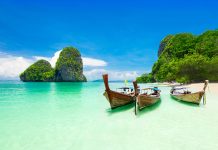CHIANG MAI, 17 March 2020: “In Search of Myanmar” is an intriguing and humorous travelogue by UK writer, James Fable, based on his two years in Myanmar (2016-2018), where he worked as a freelance travel journalist.
Title: In Search of Myanmar: Travels through a Changing Land.
Author: James Fable & Chuu Wai Nyein (illustrator).
Published: London, 13 August 13 2019, 387 pages.
Book Review: Reinhard Hohler.

The book targets a broad audience, particularly at those who wish to learn about travelling in Myanmar and gain an overview of the country’s political situation.
Fable travelled for nine months during four comprehensive journeys which took him to all of Myanmar’s seven official states. He actively taught himself the Myanmar language to a good level, which he often uses to make the book stand out from some of the other travelogues by Western writers.
The book is divided into four parts and 24 chapters, corresponding to the journeys made by Fable. His travel itineraries are clearly marked and illustrated by Chuu Wai Nyein, an artist from Mandalay, in four section maps excluding a map of Myanmar at the beginning.
There is also a helpful timeline of key events, starting with the Panglong Agreement in 1947 up to the exodus of over 700,000 Rohingya refugees from Myanmar to Bangladesh in 2017.
The book ends with an epilogue as Fable summarises the outcomes of his journeys and expresses his wish for legislative change in Myanmar politics, believing this to be the only viable route towards ending the civil wars.
Also included are a glossary of Myanmar terms, a list of abbreviations, acknowledgements, and a select bibliography.
That Myanmar has become a changing land in the last decade is proved by the possibilities of travelling all around the country without special permits, except in some sensitive areas along the international borders.
The four routes Fable took to survey the country vivify how much the country has opened up, even though there are still some 20 ethnic armed organizations fighting the Myanmar government for greater independence.
Scope of Fable’s journeys seen in his itineraries:
Part I: Yangon-Tharrawaddy-Gyobingauk-Pyay-Magway-Bagan-Monywa-Mandalay-Pyin Oo Lwin-the Gokteik viaduct-Hsipaw-Naypyidaw-Yangon
Part II: Yangon-Mawlamyaing (Pa-Auk Tawya Forest Monastery)-Ye-Dawei-Mawlamyaing-Kyaiktiyo-Yangon
Part III: Yangon-Mandalay-Khamti-Lahe-Nagaland-Tamanthi-Homalin-Mawleik-Kalaymyo-Tiddim (Rih Lake)-Falam-Hakha-Pakokku-Kyaukpadaung-Mrauk U-Sittwe-Kyaukphyu-Ngapali-Pathein-Ngwe Saung-Nyaungdon-Yangon
Part IV: Yangon-Taungoo-Thandaunggyi-Mandalay-Shwebo-Katha-Hopin-Loneton-Myitkyina-Katha-Bhamo-Mandalay-Kalaw-Taunggyi (Kakku)-Loikaw-Yangon
During his travels, Fable meets multiple engaging characters, including a monk who claims that reaching Enlightenment is “so easy” and wishes to know the exact address of his girlfriend’s home, and reflects on the myriad problems facing modern Myanmar.
His first journey begins with an ominous trip to his girlfriend’s astrologer, whose predictions shake their already fragile relationship, then takes him through Myanmar’s heartland, including to Mandalay, where he recounts the brutal human sacrifices conducted by King Mindon upon the city’s foundation. The theme of royalty continues in Hsipaw as he meets the niece of the last Shan ‘sky prince’, who was executed during Ne Win’s coup d’etat in 1962, as well as in Naypyidaw, which was built by former dictator Than Shwe and styled after the Royal Mandalay Palace.
Fable’s second journey takes him to the “empty” beaches of Dawei in Southern Myanmar, a region riddled with corruption, and includes a weeklong visit to the Pa-Auk Tawya meditation centre. However, following numerous encounters with islamophobic, often downright peculiar individuals, as well as an uninspiring trip to the Golden Rock pilgrimage site of Kyaiktiyo, he returns to Yangon feeling ambivalent towards the country that has been his home for over a year.
His mixed emotions become even more turbulent in his third journey when he travels to Hkamti in the Sagaing Region and further into Nagaland, whose locals include former headhunters who seem to be as cold as the mountains they inhabit.
Next on his itinerary are the Chin highlands, mostly populated by Christian tribal people, and then Rakhaing State, where, among other places, he visits Mrauk U, an ancient temple city similar to Bagan, and the industrial town of Kyaukphyu, which has become the site of controversial, multinational oil and gas pipelines.
Fable rediscovers his love for Myanmar in the Ayeyarwady Region at the end of his third journey, providing a nice base for the fourth and final leg of his Myanmar odyssey. This sees him travel notably to Katha, the town where George Orwell lived, and Loneton, home of the scenic Indawgyi Lake. From there he journeys to Myitkyina, the capital of Kachin State, parts of which he finds to be heavily under the influence of China, then down through Shan State and into Kayah State, where he meets the so-called “giraffe women”.
Exhausted, he has finally visited all seven states of the Union of Myanmar, has learned about the country’s severely fractured political landscape and encountered an entire spectrum of fascinating people in the meantime.
To summarize, Fable recounts stories of charismatic people – such as Olive Yang, the lesbian opium princess of Kokang – and elucidates the difficulties that Aung San Suu Kyi faces in trying to unite some 135 indigenous ethnic groups into a democratic republic. This well-researched book makes for an entertaining read and serves as a useful source, meaning it should be included in every library collection on Myanmar.
For further information, please contact by e-mail [email protected]
(Source: Book review by Reinhard Hohler)







This book will be pirated tomorrow and one can buy a copy for a dollar or two everywhere. That’s why I have almost given up publishing anymore book on Myanmar unless the government enforce the IP and copyrights laws.